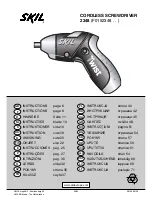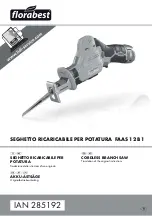
8
5. INSERTING AND CHANGING THE SAW BLADE
Always make sure the machine is discon-
nected from the mains before performing
any operation.
This jig saw is fitted with a “Quick fix” saw blade retainer.
Saw blade installation is described below:
• Fully rotate retaining lever F (Fig. 2) and maintain it
in this position.
• Fully insert the saw blade, with the rear section sup
-
ported in wheel guide H.
• Release retaining lever F and press the saw blade until
retaining lever F returns to its original position. Verify
that the saw blade is correctly fixed in place.
It is advisable to lubricate periodically the contact area
between the saw blade and support wheel (with a drop
of oil) and the support axle of the wheel itself.
6. ADJUSTING THE PENDULAR MOVEMENT
The pendulum mechanism provides blade swivel motion
with improved cutting and higher work speed per material.
To adjust with of swivel, use control E (Fig. 3). At 0
there is no swivel.
Pendular movement is increased from position 1 to
position 3.
Change of setting can be carried out with the machine
in motion.
Read the optimum operating conditions on machine label
O (Fig. 1) according to the specific material being worked.
MATERIAL
WHEEL POSITION
WOOD
1-2-3
STEEL
0
ALUMINIUM
0-1
RUBBER
0
CERAMICS
0
7. ELECTRONIC SPEED ADJUSTMENT
The machine has an electronic circuit that permits a
smooth start and maintains a practically constant speed
up to its rated power. Adjustment control D (Fig. 1) is
incorporated into the top of the knob.
Adjustment control D is used to set the required speed.
Number 1 corresponds to the minimum speed and number
6 is the maximum obtainable speed by means of the
electronic circuit. Once number 6 is exceeded the circuit
switches off and the machine works at the maximum
speed without regulation. Electronic regulation can be
carried out with the machine running.
The optimum number of strokes, depends on the material
and particularly on the working conditions which can
be achieved with practice.
If working with a reduced number of strokes for a pro
-
longed period of time, the machine should be left at a
no-load speed from time to time for a period of 1 to 3
minutes to allow the motor to cool down.
8. TYPES OF CUTS
Always make sure the machine is discon-
nected from the mains before performing
any operation.
Inclined cuts (Fig. 5)
To work with inclined cuts, loosen screw I, and incline
the base according to the desired cutting angle, which
is indicated on graduated scale P on the base itself.
Firmly tighten screw I.
The base should be placed as far forward as possible to
allow for unlimited saw blade inclination.
Vertical cuts
The base is placed as far back as possible so that the
blade is centered at pos. 2 (Fig. 5).
To start working on wood on inner cuts the assembly car
be beared through the front portion of the base plate
and slowly press until the saw blade has gone through
the material to be processed.
If there is no training or when working on other mate
-
rials it is necessary to make a previous adjustment hole.
To carry out this the pendulum mechanism should be at
position 0.
9. ANTI-SPLINTER PLATE FOR CLEAN CUTS
Always make sure the machine is discon-
nected from the mains before performing
any operation.
Anti-splinter plate K (Fig. 4) prevents the surface from
splintering when wood is being sawed.
Position anti-splinter plate K as shown in (Fig. 4) with the
fittings downwards.
To install the sliding skid, clip it onto the front of sup
-
port base L as shown in (Fig. 7). Press the rear section
upwards until it is locked in place as shown in (Fig. 8).
The anti-splinter plate cannot be used
with certain types of saw blade (for
example, jump saw blades).
Support base L (Fig. 6) which is fitted with a steel insert
provides a high degree of stability and may be used
without sliding skid J (Fig. 8) to work on metal or other
non-delicate surfaces.
It is recommended that sliding skid J is used with ma
-
terial that is easily scratched in order not to damage
delicate surfaces.
Summary of Contents for 3400300
Page 33: ...33 Fig 1 Fig 2 Fig 3 Fig 4 Fig 5 Fig 6 B D O A L E P J M ...
Page 34: ...34 Fig 7 Fig 8 ...
Page 35: ......









































